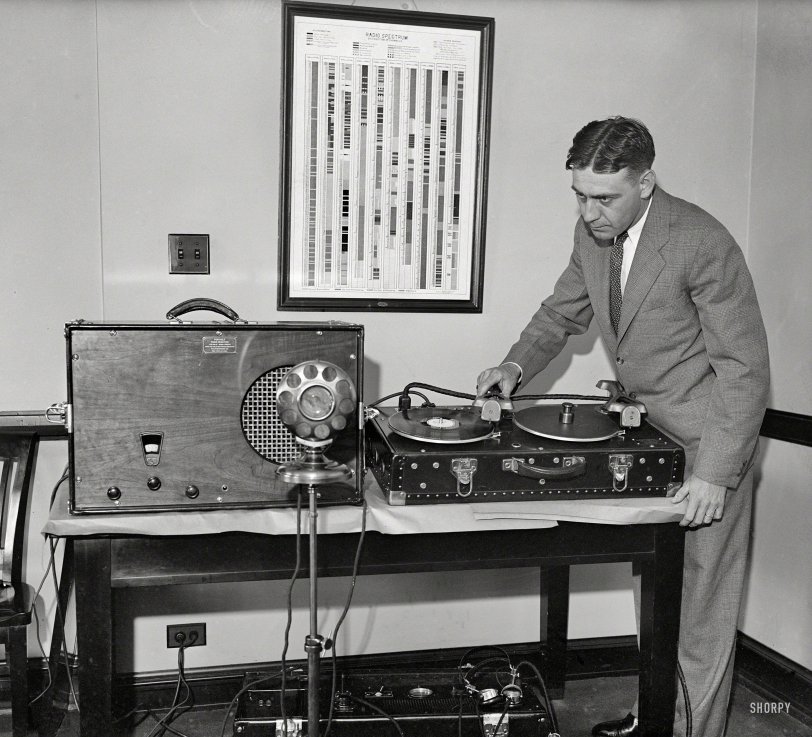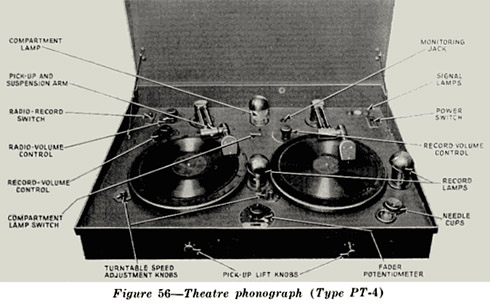


Framed or unframed, desk size to sofa size, printed by us in Arizona and Alabama since 2007. Explore now.
Shorpy is funded by you. Patreon contributors get an ad-free experience.
Learn more.

- Baldwin 62303
- Baldwin VO-1000
- Cold
- No expense spared
- Tough Guys
- Lost in Toyland
- And without gloves
- If I were a blindfolded time traveler
- Smoke Consumer Also Cooks
- Oh that stove!
- Possibly still there?
- What?!?
- $100 Reward
- Freeze Frame
- Texas Flyer wanted
- Just a Year Too Soon
- WWII -- Replacing men with women at the railroad crossing.
- Yes, Icing
- You kids drive me nuts!
- NOT An Easy Job
- I wonder
- Just add window boxes
- Icing Platform?
- Indiana Harbor Belt abides
- Freezing haze
- Corrections (for those who care)
- C&NW at Nelson
- Fallen Flags
- A dangerous job made worse
- Water Stop
Print Emporium
D.C. DJ: 1931

Washington, D.C., 1931. "Man with portable radio receiver and phonograph." Who seems to be using the amplifier to play a record into a microphone. Note handy "Radio Spectrum" chart. Harris & Ewing glass negative. View full size.
Federal Radio Commission recorder
This description is from a news photo in 1931:
A new type of portable radio recorder has been invented. The apparatus is a portable disc equipment consisting of two motor-driven turntables, a recording amplifier, a nmicrophone, radio receiver and a loudspeaker. Pre-grooved blank disc records are placed upon each of the turntables, and when in operation, with sound being recorded as it emanates from a loudspeaker, the records operate continuously and automatically change from one to the other. This device is expected to help the Federal Radio Commission in settling any problems of programs on the air, having had to use stenographic reports until now.
Surprisingly light
I have a working 1933 RCA Victor combination radio phonograph with a very similar tone arm and thumb screw needle. I don't know if it's made of aluminum or pot metal, but it doesn't weigh nearly as much as it looks as though it would. I wouldn't try it on a 1950s or newer plastic record, but it does well playing both the pre-war shellack and Durium cardboard Hit Of The Week 78s of that era.
Victor Home Recording Blank
From the label I can identify the record as a Victor Home Recording blank. The plastic records were pre-grooved, so the recording process was done by embossing, not cutting. It's a little harder to judge, but from the photo it looks like the grooves are already modulated, so we're seeing the record being played back.
Electrical Transcription
Actually, what is happening here is the production of an electrical transcription. The disk isn't being played into the microphone--it's going the other direction. The radio broadcast is being recorded onto the disks for playback later or for archival purposes.
When I worked in radio in the early eighties, there was still a check box on the daily log to indicate that the audio source was "ET." I suspect things have caught up by now.
[The turntable is an RCA Photophone similar to the "Theatre Phonograph" in the illustration below. These were used to play background music during seating and intermission in the early days of sound pictures. They could also be used to pipe radio into the cinema. - Dave]


Spectrum chart
I would love to get a close look at that spectrum chart. In 1931 40 megahertz ("megacycles" in those days) was about the limit of radio technology. Today I have a spectrum chart on my wall that goes to 150 gigahertz. That's 150,000 megahertz.
Heavy, dude, heavy...
Those cartridges and headshells look like they weigh at least 16 pounds - hope those records are made of something a little more substantial than acetate...
Two turntables and a microphone
This is an amazing 39 years before Beck was born
























On Shorpy:
Today’s Top 5